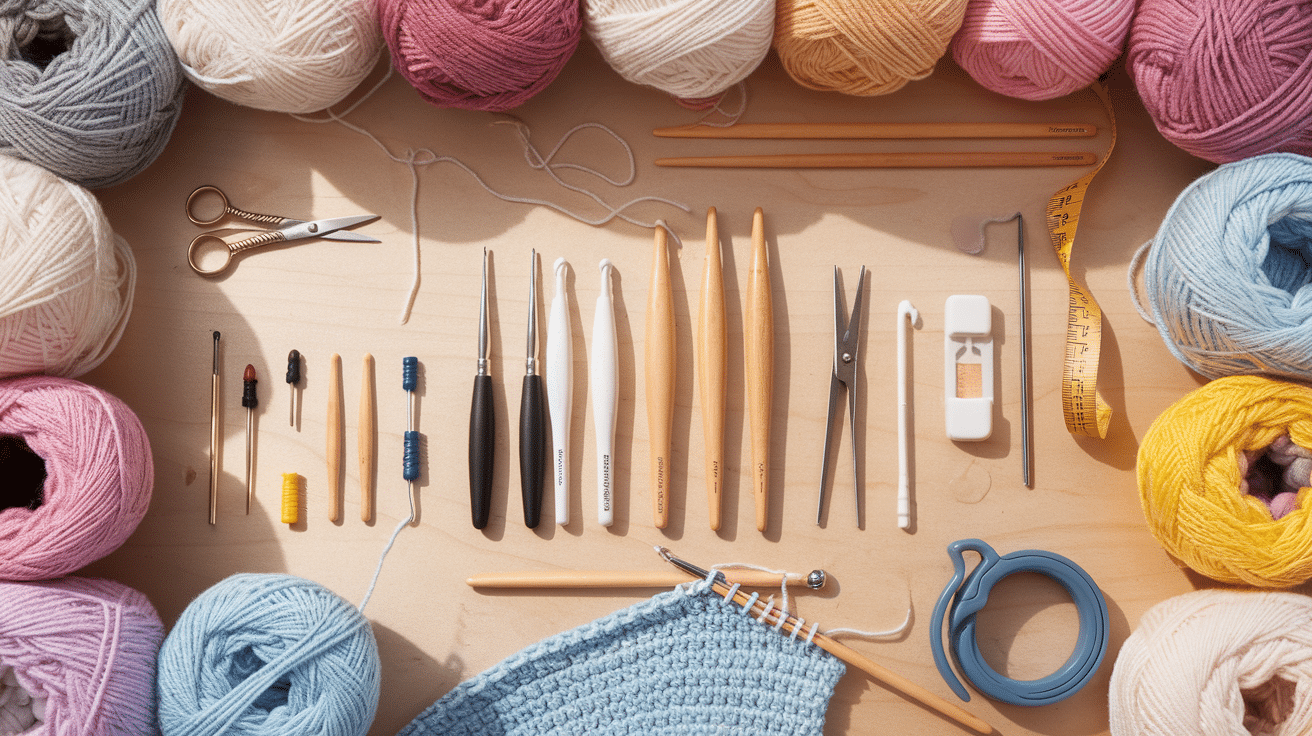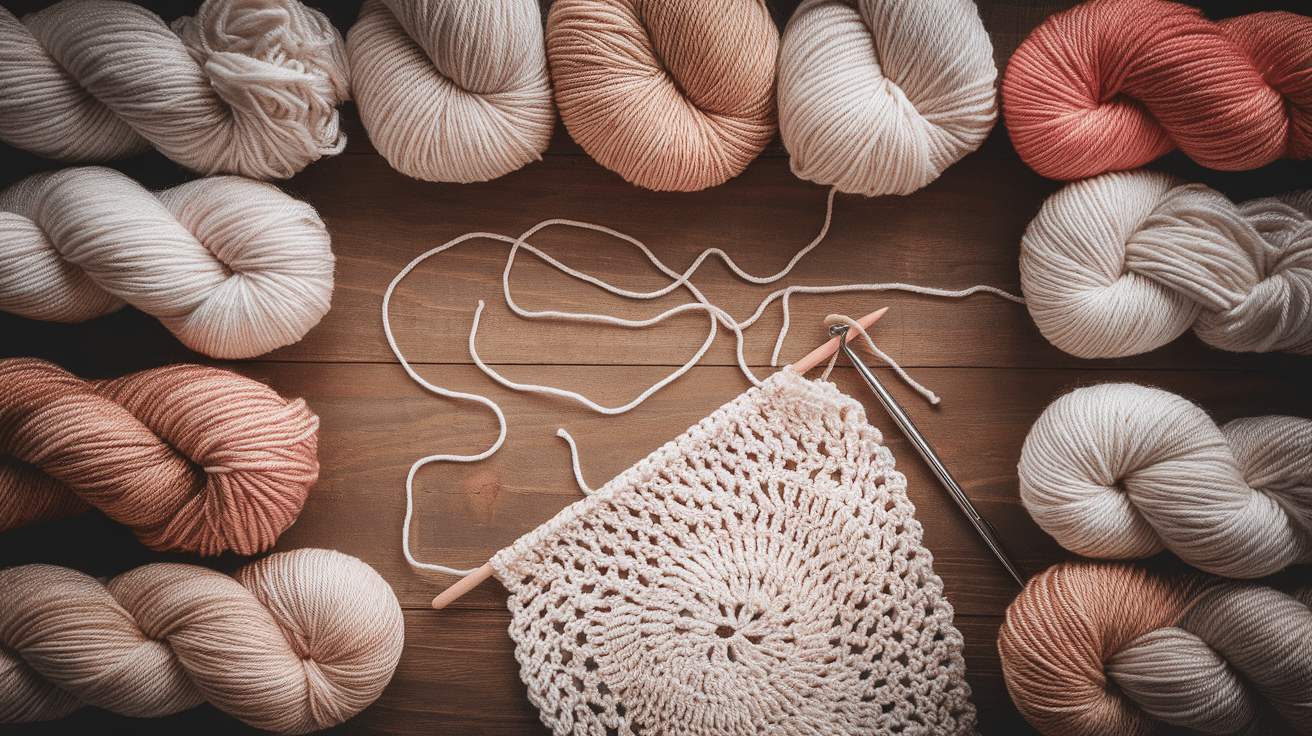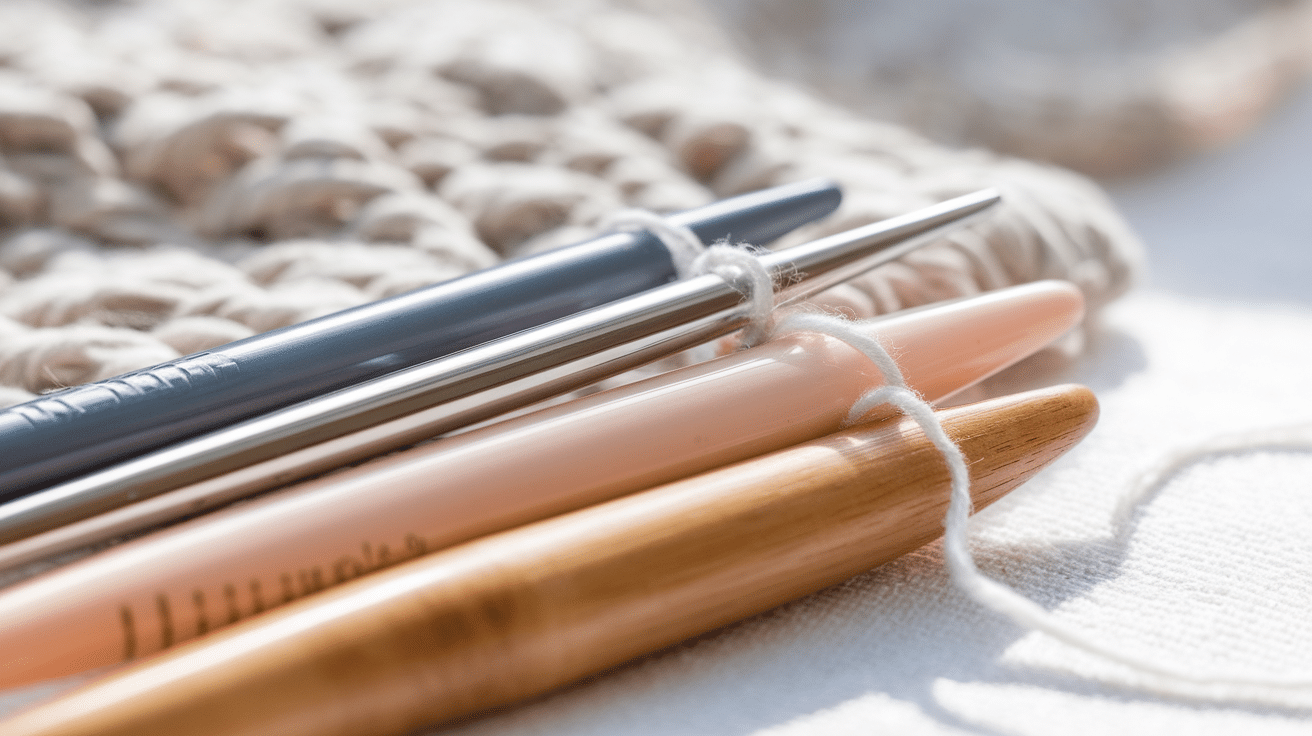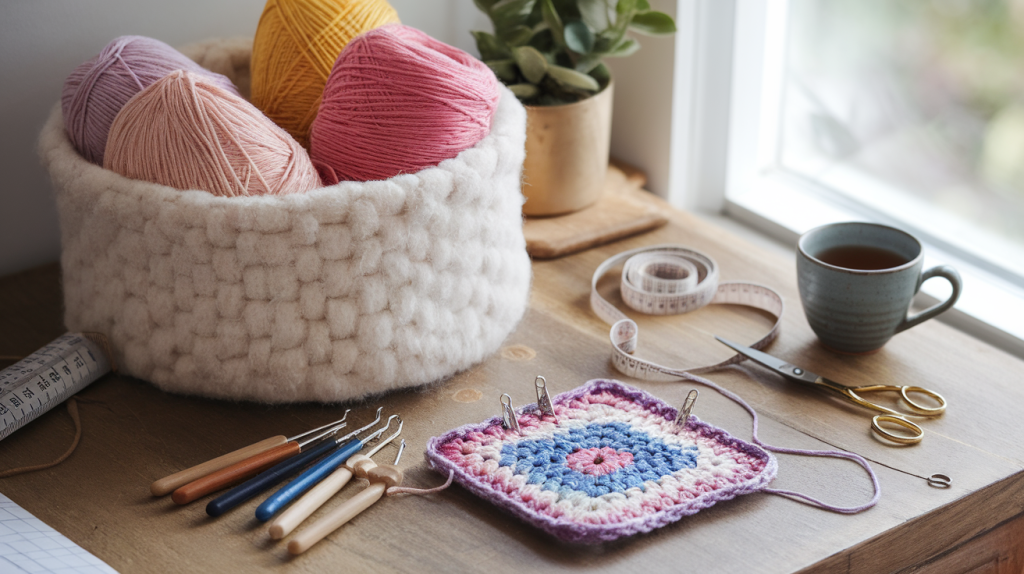Choosing the right crochet materials is important for creating strong and well-made projects. The type of yarn, hook, and additional supplies used can affect the final look, texture, and durability of the piece.
Yarn comes in different fibers, weights, and textures, each suited for specific projects. Some fibers work better for clothing, while others are best for home decor or accessories. Using the right crochet hook ensures smooth stitching and prevents strain on the hands.
Good-quality materials make crocheting easier and more enjoyable. They also help finished projects last longer. Understanding different options allows crafters to select the best supplies for their needs. With the right materials, crocheting becomes a more rewarding and stress-free experience.
What is Crochet Material?

Crochet material refers to the essential tools and supplies used to create crochet projects. These materials include yarn, crochet hooks, and various accessories that help maintain even stitches, improve efficiency, and enhance the durability of finished pieces.
Choosing the right crochet material is important, as it directly affects the ease of crocheting and the quality of the final product.
Primary Materials
- Yarn: This is the foundation of every crochet project. It comes in different fibers, such as cotton, wool, acrylic, and blends. The type of yarn affects texture, appearance, and durability.
- Hooks: Crochet hooks vary in size and material, including aluminum, plastic, and wood. Using the correct hook ensures smooth stitching and comfort during long crochet sessions.
Supporting Accessories
- Scissors: A sharp pair of scissors helps cut yarn cleanly and prevents fraying.
- Stitch Markers: These small tools assist in tracking stitches, especially in detailed patterns or circular projects.
- Tapestry Needles: Used for weaving in yarn ends and securing stitches to give projects a clean finish.
- Measuring Tape: Ensures accuracy in size and dimensions for garments and accessories.
Selecting high-quality crochet materials improves stitch accuracy, prevents hand strain, and enhances the overall crochet experience. Using the right tools makes crocheting more efficient and enjoyable for both beginners and experts.
Essential Crochet Materials for Beginners
Choosing the right crochet materials is key to making the learning process smooth and enjoyable. Beginners should focus on selecting quality yarn, hooks, and essential accessories that help improve stitch consistency and overall project durability.
With the right materials, crocheting becomes easier, reducing frustration and allowing for better results.
Yarn – The Foundation of Every Crochet Project

Yarn is the primary material in crochet, and its texture, thickness, and fiber type impact the final outcome.
There are different types of yarn fibers, each suited for specific projects:
- Cotton: Ideal for dishcloths, summer clothing, and home décor because of its strength and defined stitches. It has a little stretch but provides excellent durability.
- Acrylic: A widely used synthetic fiber that is soft, affordable, and available in a variety of colors. It is great for blankets, scarves, and hats since it is machine washable and easy to maintain.
- Wool: Perfect for cold-weather projects like sweaters, socks, and beanies. It is warm, stretchy, and retains shape well, but some types require careful washing.
Yarn weights also play a big role in the outcome of crochet projects. Beginners should start with medium-weight yarn (worsted weight), as it is easier to handle and works well with standard hooks. Light-colored yarn is also recommended since it helps new crocheters see their stitches clearly.
Crochet Hooks – Finding the Right One

Crochet hooks come in different materials and sizes, affecting how easily the yarn moves and how comfortable the hook feels in hand. The main types include:
- Aluminum Hooks: These are lightweight, smooth, and durable. They allow the yarn to glide easily, making them a popular choice for beginners.
- Plastic Hooks: Lightweight and budget-friendly, but they may not be as smooth as aluminum. They are a good option for those who want an affordable alternative.
- Bamboo Hooks: These have a natural texture that provides a good grip. They are comfortable to hold but may create friction, slowing down stitching.
Hook size is just as important as the material. The size of the hook should match the yarn weight to create even stitches. For beginners, a 5mm or 6mm hook (size H or J) paired with medium-weight yarn is an excellent starting point.
If crocheting for long periods, ergonomic hooks with cushioned handles reduce hand strain and improve comfort.
Additional Tools – Scissors, Stitch Markers, and Needles
Beyond yarn and hooks, a few essential tools make crocheting more efficient and organized:
- Scissors: A sharp pair of scissors is necessary for cutting yarn cleanly and preventing fraying. Small craft scissors are easy to handle and store in a crochet kit.
- Stitch Markers: These help keep track of stitches, especially in complex patterns or circular projects. Removable stitch markers are the best option for beginners.
- Tapestry Needles: Used for weaving in yarn ends and sewing crochet pieces together. Large-eyed needles are ideal for working with different yarn thicknesses.
Having the right crochet materials makes learning easier and ensures better project results. Beginners who invest in quality supplies will have a more enjoyable experience and be able to focus on mastering crochet techniques.
Understanding Advanced Crochet Materials
As crocheters gain experience, they may want to explore new techniques and materials that offer more variety and creative possibilities. Advanced crochet materials include specialty yarns, unique hooks, and optional accessories that improve efficiency and precision.
Choosing the right tools for complex projects can enhance the final outcome and make intricate patterns easier to manage.
Specialty Yarns and Their Uses
Beyond standard yarns, advanced crocheters often work with specialty fibers that add texture, color variation, and a unique feel to projects.
Some of the most common specialty yarns include:
- Textured Yarn: Includes boucle, chenille, and fuzzy yarns that add dimension but can be tricky to work with due to their irregular surfaces.
- Variegated Yarn: Features multiple colors in a single strand, creating natural color changes without the need for switching yarns manually. Ideal for scarves, shawls, and blankets.
- Luxury Yarn: Includes fibers like alpaca, silk, and cashmere, which are softer and more delicate. These yarns require extra care but offer an elegant finish.
- Lace Yarn: A fine, lightweight yarn used for intricate patterns such as doilies, shawls, and decorative pieces.
Each yarn type serves a specific purpose, and using the correct one ensures better stitch definition and durability in advanced crochet projects.
Hooks for Special Techniques
Advanced crocheting often involves special hooks designed for specific techniques that go beyond traditional stitches.
Some of the most useful specialized hooks include:
- Tunisian Crochet Hooks: Longer than standard hooks, these are designed for Tunisian crochet, a technique that combines elements of knitting and crochet. They allow multiple loops to stay on the hook, creating a woven texture.
- Double-Ended Hooks: Used for working in the round or creating double-sided crochet fabrics. These hooks allow crocheters to switch between two yarn colors or create reversible stitches.
Using the right hook for advanced techniques improves stitch control and ensures the project turns out as intended.
Optional Accessories for Efficiency
As projects become more complex, additional tools can help maintain accuracy and improve workflow. Some useful accessories include:
- Row Counters: Essential for tracking row numbers in large or detailed projects, reducing the chances of errors.
- Blocking Mats: Used to shape and define finished pieces, ensuring they hold their intended structure. This is especially helpful for lacework and garments.
- Needle Threaders: Helpful for working with fine yarns or when threading a small tapestry needle for finishing details.
Advanced crochet materials open up new creative opportunities, allowing crocheters to experiment with intricate patterns and high-quality finishes.
Having the right tools and yarns makes it easier to take on challenging projects while maintaining comfort and efficiency.
How to Choose the Right Crochet Material for Your Project
Selecting the right crochet materials is essential for achieving the best results in any project. The type of yarn, hook size, and material quality all influence the final outcome.
Choosing the right combination ensures durability, comfort, and ease of crocheting. Making clothing, accessories, or home décor requires understanding how different materials interact to create high-quality pieces.
Matching Yarn Type to the Project
Different yarns work better for different types of projects. Cotton yarn is a great choice for summer garments, dishcloths, and lightweight accessories because it is breathable and sturdy. Wool yarn is best for warm blankets, scarves, and winter clothing since it retains heat well.
Acrylic yarn is a budget-friendly option that works for a variety of projects, including baby blankets and sweaters. Some yarns combine fibers like cotton and acrylic, offering both softness and durability.
Picking the Right Hook Size
Hook size plays a key role in how the final project looks and feels. Larger hooks create looser stitches, making the fabric more flexible and airy. Smaller hooks produce tighter stitches, which are great for sturdy and detailed designs.
Every yarn label provides a recommended hook size, helping crafters select the best match for their project. Testing different hook sizes before starting ensures the fabric turns out as expected.
Considering Texture, Elasticity, and Durability
Texture affects both the look and feel of a crochet piece. Smooth yarns glide easily on the hook, making them ideal for beginners.
Textured yarns add depth to a design but may be harder to work with. Elasticity matters when making garments, as stretchy yarns provide a better fit.
Durability is another key factor, especially for items like bags or rugs that need to withstand frequent use. Choosing materials based on these qualities helps create functional and long-lasting crochet pieces.
Caring for Your Crochet Materials
Taking care of crochet materials helps maintain their quality and extends their usability. Proper storage and regular maintenance of yarn, hooks, and accessories prevent damage and make crocheting more enjoyable. Keeping materials in good condition ensures smooth stitching and better project results.
Storing Yarn Properly
To prevent damage, the yarn needs to be stored in a clean, dry place. Keeping it in airtight containers or fabric storage bags helps protect it from dust, moisture, and pests.
Plastic bins with lids work well for long-term storage, while baskets or shelves provide easy access for frequent use.
Avoid leaving yarn in direct sunlight, as prolonged exposure can fade colors and weaken fibers. To prevent tangling, winding loose yarn into cakes or skeins keeps it neat and ready to use.
Maintaining Hooks and Accessories
Crochet hooks, especially metal ones, should be cleaned regularly to prevent rust or buildup from hand oils.
Wiping hooks with a soft cloth and mild cleaner keeps them smooth and easy to use. Storing them in a case or organizer helps prevent loss and keeps them from getting bent or scratched.
Stitch markers, scissors, and needles should also be kept in a small storage box or pouch for easy access. Proper organization makes crocheting more efficient and ensures materials stay in good shape for future projects.
Conclusion
Choosing the right crochet materials makes a big difference in the success of any project. The right yarn, hooks, and accessories help create smooth stitches, improve comfort, and make crocheting easier. Investing in good-quality materials ensures durability and better results.
Experimenting with different yarn types and hook sizes allows crafters to find what works best for their style.
Soft cotton, stretchy wool, or lightweight acrylic all offer unique benefits. Using the right tools, such as ergonomic hooks or stitch markers, also improves the crocheting experience.
Having well-maintained materials leads to enjoyable and frustration-free crocheting. With proper care and organization, crochet supplies last longer and remain in great condition. The right materials make the process more fun, creative, and rewarding.
Frequently Asked Questions
What Is the Best Yarn for Beginners in Crochet?
Cotton and acrylic yarns are great for beginners because they are easy to work with, widely available, and hold stitches well. Medium-weight yarn is often recommended for easy handling.
How Can I Keep My Yarn from Tangling?
Store yarn in sealed containers, use yarn bowls to control unwinding, and avoid pulling from the center if it causes knots. Keeping the yarn in a tidy space helps prevent tangles.
What Tools Do I Need to Start Crocheting?
Basic crochet tools include yarn, hooks, scissors, stitch markers, and a tapestry needle. These essentials make it easier to create and finish projects.
How Do I Clean and Store My Crochet Hooks?
Wipe hooks regularly with a soft cloth to remove dust and oil. Store them in a case or organizer to prevent damage. Metal hooks should be kept dry to avoid rust.
Why Does My Crochet Project Feel Too Tight or Too Loose?
Tension affects how stitches look. If stitches are too tight, try using a larger hook or loosening the grip. If they are too loose, switch to a smaller hook or adjust hand movements.









